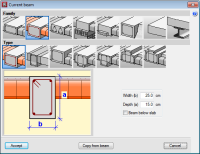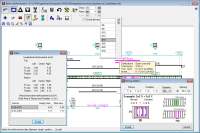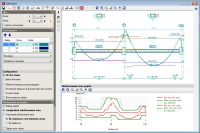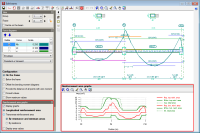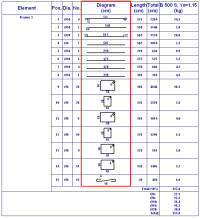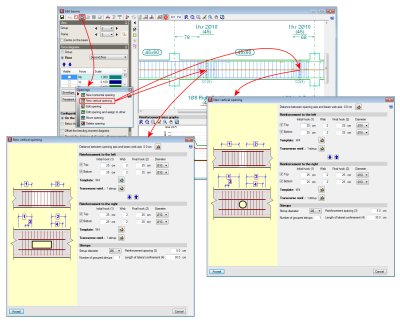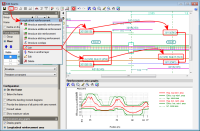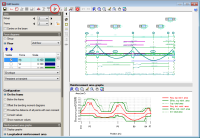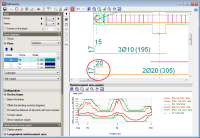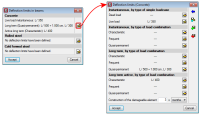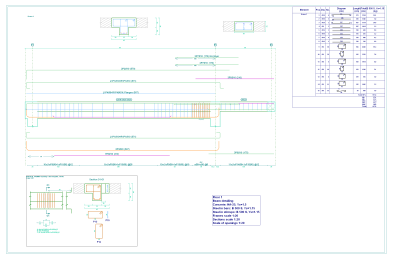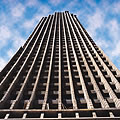
- Data entry
- Results analysis
- Beam editors in CYPECAD
- Advanced beam editor
- Detailed U.L.S. and S.L.S. check reports for concrete beams (with check for failure due to torsion and design criteria for seismic loads)
- U.L.S. and S.L.S. reports for steel beams
- Required and effective reinforcement area diagrams
- Bar bending schedule and reinforcement configuration of the reinforcement details in the frame drawings
- Horizontal and vertical openings in concrete beams
- Other options of the Advanced beam editor
- Design codes available for use with the Advanced beam editor
- More results analysis options
- Drawings and reports
- CYPECAD and CYPE 3D modules
Data entry
Using the Concrete beams module, users can introduce and design the following types of concrete beams:
- Rectangular section beams:
Flat, dropped (downward drop or inverted), or dropped with collaborating compression head. - ‘L’ or ‘T’ beams:
Flat and dropped (downward drop or inverted with collaborating compression head with greater or equal depth than the slab). - Precast lattice beams:
Flat beams with rectangular, ‘L’ or ‘T’ transverse sections; and dropped beams with rectangular transverse sections. - Beams with external fixity (infinitely rigid beams):
Beams with free displacement and free rotation, with fixed displacement and free-rotation, and with fixed displacement and rotation. - Prestressed beams:
Flat and dropped beams with rectangular, ‘L’ or ‘T’ transverse sections. - Non-structural or limit beams (non-rigid beams).
CYPECAD also designs steel, composite beams (with shear studs) and foundation beams, although the Steel beams module and Mat foundations and foundation beams module would be required respectively.
Beams can have a straight or curved axis and the program allows for both of them to be introduced in ‘Continuous mode’ (the final point of the beam that is marked is the initial point of the next) or in ‘Simple mode’ (once the final point of the beam is marked, if another beam is to be introduced, the initial point of the next beam has to be marked).
The faces or axis of the beams can be adjusted to a reference point (column axes, beam ends or snaps to elements of a drawing file with DXF or DWG format). The selected adjustment (faces or axis of the beam to be introduced) can be displaced with respect to the reference points.
CYPECAD can also automatically assign a beam outline to a polygon (open or closed) in a DXF or DWG drawing. The faces or axis of the beam can be adjusted to the polygon, and even apply a specific displacement. Another feature of CYPECAD is the automatic introduction of the beams of the floor slabs following the instructions of the users and the outlines of the floor displayed in the DXF or DWG drawing template. Both these tools belong to the Automatic job introduction module.
The program contains tools that allow for the interaction of the beams with the rest of the structure to be defined. Users can pin beams at either end, modify the fixity coefficient of the faces of the beams, assign minimum moments, manage the beam alignments that are generated (consecutive spans, which the program considers to be a single frame), divide or join alignments, and introduce a beam that is shared between two floors.
Results analysis
Beam editors in CYPECAD
CYPECAD has two beam editors available to users: the beam editor for earlier versions than the 2013.e version and the Advanced beam editor, which was implemented in the 2013.e version.
The beam editor, which is available for versions earlier than the 2013.e version, allows for the reinforcement to be modified graphically. Reinforcement bars, anchorages and stirrups can be added, deleted, matched, divided and modified. The real and required reinforcement areas of each span of the frame can also be consulted.
The Advanced beam editor contains more features for users to analyse the design carried out by CYPECAD.
The choice of which editor to use depends on the concrete and seismic design codes selected for the design of the structure (Job > General data). More information on the codes for which the Advanced beam editor is available can be consulted in the section: Design codes available for use with the Advanced beam editor, of this webpage. More design codes are added to the current list with each program version.
Advanced beam editor
The Advanced beam editor provides users with a very effective tool to revise and modify the design of concrete and steel beams. It allows users to consult a wide range of information on the selected frame, which is automatically updated when any changes are carried out (Results > Beams/Walls > Edit beams). It consists of the same beam editor used in Continuous beams. It provides a quick and comfortable graphical edition interface for the resistant elements of the frame (reinforcement bars, steel sections, lattices, shear studs, etc). It also provides:
- Detailed U.L.S. and S.L.S. check reports for concrete beams (with check for failure due to torsion and design criteria for seismic loads)
- U.L.S. and S.L.S. reports for steel beams
- Required and effective reinforcement area graphs
- Bar bending diagrams and reinforcement configuration option on the frame drawings
- Horizontal and vertical openings in concrete beams
- Other options of the Advanced beam editor
More information on the codes for which the Advanced beam editor is available can be consulted in the section: Design codes available for use with the Advanced beam editor, of this webpage
Detailed U.L.S. and S.L.S. check reports for concrete beams (with check for failure due to torsion and design criteria for seismic loads)
CYPECAD, using its Advanced beam editor, generates Detailed Ultimate and Serviceability (U.L.S. and E.L.S.) Limit State check reports for concrete beams (![]() and
and ![]() buttons of the editor). The articles of the codes in accordance to which the checks refer to are also indicated.
buttons of the editor). The articles of the codes in accordance to which the checks refer to are also indicated.
More features of the beam editor are present in CYPECAD than in Continuous beams due to the torsional and seismic analysis performed by CYPECAD. The U.L.S. and E.L.S. reports provided in CYPECAD include checks for failure due to torsion in reinforced concrete beams and also incorporates the specific checks of the design criteria for seismic loads for reinforced concrete beams (including the shear capacity design criteria).
U.L.S. and S.L.S. reports for steel beams
The detailed U.L.S. and S.L.S. check reports for steel beams (![]() and
and ![]() buttons of the editor) and the steel beam series check (
buttons of the editor) and the steel beam series check (![]() button of the editor) are also obtained in the new beam editor. For jobs for which the Advanced beam editor is not available (depends on the selected design code), the detailed U.L.S. and S.L.S. check reports are obtained using the Beam errors option in the Beams/Walls option in the Results tab).
button of the editor) are also obtained in the new beam editor. For jobs for which the Advanced beam editor is not available (depends on the selected design code), the detailed U.L.S. and S.L.S. check reports are obtained using the Beam errors option in the Beams/Walls option in the Results tab).
Required and effective reinforcement area diagrams
CYPECAD’s Advanced beam editor includes diagrams indicating the required and effective areas of the reinforcement provided in the edited frame.
Bar bending schedule and reinforcement configuration of the reinforcement details in the frame drawings
The frame drawings include, within the reinforcement details, the bar bending schedule for the longitudinal and transverse reinforcement of the frame (File > Print > Job drawings > Select Frames drawings as the type of drawing > Activate Reinforcement layout in the drawing to be generated).
The bar bending schedule is also included in the Column detailing drawings (File > Print > Job drawings) and in the reinforcement of the Punching shear verification program.
The reinforcement details to be displayed in the drawings can be configured using the Advanced beam editor. There are two options:
- Details of reinforcement outside of the frame
The reinforcement details are drawn outside the longitudinal section of each frame.
- Reinforcement details only in the table
The reinforcement details are not drawn in the frame and are only displayed in the reinforcement schedule or details table.
Horizontal and vertical openings in concrete beams
CYPECAD’s Advanced beam editor and Continuous beams allow users to introduce horizontal or vertical openings (rectangular or circular) in reinforced concrete beams.
More information on the introduction of horizontal openings can be found in the new features of the 2014.a version and on vertical openings (introduction, reinforcement definition, U.L.S. checks and reinforcement details on drawings) in the new features of the 2014.b version.
Other options of the Advanced beam editor
The Advanced beam editor contains more tools and options for editing the reinforcement. Below is a sample of these tools:
- Join additional, assembly or skin reinforcement
Activated using the button from the top toolbar of the beam editor.
button from the top toolbar of the beam editor.
Regarding the additional reinforcement bars, the program allows for reinforcement of the same diameter to be joined without substituting the reinforcement of one span for that of the other. When joining the assembly or skin reinforcement, the program substitute the reinforcement selected in second place will be substituted by those that were selected first (regardless of the number of bars and diameter).
- Block or unblock the reinforcement of the frame
This option is represented by an icon situated in the View section of the lateral menu of the new beam editor. This icon can be represented in two ways: open padlock ( ) or closed padlock (
) or closed padlock ( ). The open padlock (
). The open padlock ( ) indicates the reinforcement of the frame being edited is not blocked and the closed padlock (
) indicates the reinforcement of the frame being edited is not blocked and the closed padlock ( ) indicates it is blocked. By clicking on the icon, the blocked status of the beam reinforcement changes. Blocking of the reinforcement is only effective for actions carried out outside the editor. In other words, if the frame's reinforcement is blocked, (
) indicates it is blocked. By clicking on the icon, the blocked status of the beam reinforcement changes. Blocking of the reinforcement is only effective for actions carried out outside the editor. In other words, if the frame's reinforcement is blocked, ( ) CYPECAD will not be able to modify it with any of the reinforcement options or even by analysing the job (Beam Definition tab > Analyse). Nonetheless, even if the reinforcement of the frame is blocked (
) CYPECAD will not be able to modify it with any of the reinforcement options or even by analysing the job (Beam Definition tab > Analyse). Nonetheless, even if the reinforcement of the frame is blocked ( ), it can be modified in the Beam editor (changing it manually or using the Redesign button ).
), it can be modified in the Beam editor (changing it manually or using the Redesign button ).
- Redesign the frame reinforcement
The Redesign frame option is represented by the button, located in the top toolbar of the beam editor. This option redesigns the frame with the forces calculated by CYPECAD, even if the option to block the reinforcement (
button, located in the top toolbar of the beam editor. This option redesigns the frame with the forces calculated by CYPECAD, even if the option to block the reinforcement ( ) of the frame is activated in the editor.
) of the frame is activated in the editor.
- Curve representation for bent bars
The reinforcement anchorage curves are represented, in the beam editor and in the reinforcement drawings, in accordance with the selected code.
- Marks at bar ends which are anchored without any bends
The program marks (using inclined lines) bars which are anchored without any bends. These marks are only provided if the ends of the bars are drawn overlapping other bars, (due to them being in the same horizontal plane). This way, users can identify where the bar begins and ends within the longitudinal section of the frame. These marks are visible within the on-screen display of the longitudinal section of the frame and on reinforcement details drawings.
Design codes available for use with the Advanced beam editor
CYPECAD’s Advanced beam editor is available for the following concrete design codes:
- ABNT NBR 6118:2007 (Brazil)
Norma Brasileira ABNT NBR 6118 (2007). Projeto de estruturas de concreto - Procedimento. - ACI 318M-08 (USA)
Building Code Requirements for Structural Concrete (ACI 318M-08). - BAEL 91 (R-99) (France)
Règles techniques de conception et de calcul des ouvrages et constructions en béton armé suivant la méthode des états limites. - CIRSOC 201-2005 (Argentina)
Reglamento Argentino de Estructuras de Hormigón. - EHE-08 (Spain)
Instrucción de hormigón estructural. - Eurocode 2 (EU)
Design of concrete structures. EN 1992-1-1:2004/AC 2008 - Eurocode 2 (France)
Calcul des structures en béton. NF EN 1992-1-1 :2005/NA: Mars 2007 - Eurocode 2 (Portugal)
Projecto de estruturas de betão. NP EN 1992-1-1:2010/NA - Eurocode 2 (Romania)
Eurocode 2: Design of concrete structures. SR EN 1992-1-1:2004/AC
- IS 456: 2000 (India)
Indian Standard. Plain and reinforced concrete code of practice (Fourth Revision). - NCh 430.Of2008 (Chile)
Norma Chilena oficial NCh430.Of2008 (Based on ACI 318-05). - NSR-10 (Colombia)
Reglamento Colombiano de Construcción Sismo Resistente NSR-10. Título C Concreto estructural. - NTCRC:2004 (Mexico)
Normas técnicas complementarias del reglamento de construcciones para el Distrito Federal. - NTE E.060: 2009 (Peru)
Reglamento nacional de edificaciones. Norma E.060 Concreto Armado.
- SP 63.13330.2012 (Russian Federation)
Concrete and reinforced concrete. Construction. Updated edition SNIP 52-01-2003. Moscow 2012
If users carry out a seismic analysis of the structure, the Advanced beam editor will be available if the concrete code and seismic code are compatible. For each indicated concrete code, the compatible seismic codes are as follows:
- ABNT NBR 6118:2007 (Brazil)
- ABNT NBR 15421:2006 (Brazil)
Projeto de estruturas resistentes a sismos - Procedimento. - 1997 UBC (USA)
Uniform Building Code. - 2009 IBC (USA)
International Building Code. - 2011 PRBC (Puerto Rico)
Puerto Rico Building Code
- ABNT NBR 15421:2006 (Brazil)
- ACI 318M-08 (USA)
- 1997 UBC (USA)
Uniform Building Code. - 2009 IBC (USA)
International Building Code. - 2011 PRBC (Puerto Rico)
Puerto Rico Building Code - ASCE 7-05 (USA)
Minimum Design Loads for Buildings and Other Structures. - NBDS-2006 (Bolivia)
Norma Boliviana de Diseño Sísmico (2006). Título A. Análisis y diseño sismo resistente. - CFE93 (Mexico)
Manual de Diseño de Obras Civiles. Diseño por Sismo. - CFE 2008 (Mexico)
Manual de Diseño de Obras Civiles. Diseño por Sismo. Comisión Federal de Electricidad. México 2008. - CPE INEN 5:2001 (Ecuador)
Código Ecuatoriano de la Construcción. Requisitos Generales de Diseño: Peligro Sísmico, Espectros de Diseño y Requisitos Mínimos de Cálculos para Diseño Sismo-Resistente. - CSCR-2010 (Costa Rica)
Código Sísmico de Costa Rica 2010. - NC 46:1999 (Cuba)
Construcciones sismo resistentes. Requisitos básicos para el diseño y construcción. - NEC -11 (Ecuador)
Norma Ecuatoriana de la Construcción. Capítulo 2.- Peligro sísmico y requisitos de diseño. - NSE-10 (Guatemala)
Normas de Seguridad Estructural de Edificaciones y Obras de Infraestructura para la República de Guatemala, edición 2010. - NSR-10 (Colombia)
Reglamento Colombiano de Construcción Sismo Resistente (2010). - CHOC-04 (Honduras)
Código Hondureño de la Construcción. Normas Técnicas Complementarias. XII. Cargas y Fuerzas Estructurales. Diseño por Sismo. - REP-04 (Panama)
Reglamento para el Diseño Estructural en la República de Panamá 2004 (REP-04). - R-001 2011 (Dominican Republic)
Reglamento para el Análisis y Diseño Sísmico de Estructuras. - COVENIN 1756-1:2001 (Venezuela)
Norma Venezolana COVENIN 1756-1:2001. Edificaciones sismorresistentes. - IS 1893:2002 (India)
Criteria for earthquake resistant design of structures. Part 1 General Provisions and Buildings (Section 7.5) - IS 13920:1993 (India)
Ductile detailing of reinforced concrete structures subjected to seismic forces - Code of practice
- 1997 UBC (USA)
- BAEL 91 (R-99) (France)
- PS 92 (France)
Règles de Construction Parasismique - Règles PS applicables aux bâtiments – PS 92. - PS 92 (version révisée 2010) (France)
Règles de Construction Parasismique - Règles PS applicables aux bâtiments – PS 92 (version révisée 2010). - RPA 99/v 2003 (Algeria)
Règles Parasismiques Algériennes RPA 99 / VERSION 2003 - RPS 2000 (Morocco)
Règlement de Construction Parasismique. - RPS 2011 (Morocco)
Règlement de Construction Parasismique (version révisée 2011).
- CIRSOC 201-2005 (Argentina)
- CIRSOC 103-2008 (Argentina)
Normas Argentinas para Construcción Sismorresistente - Proyecto de Reglamento CIRSOC 103, Parte I: Construcciones en general. Se utilizan los criterios de armado por ductilidad y criterios de diseño sísmico por capacidad del reglamento CIRSOC 103-2005 (Normas Argentinas para Construcción Sismorresistente. Parte II: Construcciones de Hormigón Armado). - CIRSOC 103-1991 (Argentina)
Normas Argentinas para Construcción Sismorresistente. Reglamento CIRSOC 103 Parte I: Construcciones en general. Se utilizan los criterios de armado por ductilidad y criterios de diseño sísmico por capacidad del reglamento CIRSOC 103-2005 (Normas Argentinas para Construcción Sismorresistente. Parte II: Construcciones de Hormigón Armado). - 1997 UBC (USA)
Uniform Building Code. - 2009 IBC (USA)
International Building Code. - 2011 PRBC (Puerto Rico)
Puerto Rico Building Code.
- EHE-08 (Spain)
- NCSE-02 (Spain)
Norma de Construcción Sismorresistente. Parte general y Edificación. - 1997 UBC (USA)
Uniform Building Code. - 2009 IBC (USA)
International Building Code. - 2011 PRBC (Puerto Rico)
Puerto Rico Building Code
- Eurocode 2 (EU)
- Eurocode 8 (EU)
EN 1998-1. Eurocode 8: Design of structures for earthquake resistance. Part 1: General rules, seismic actions and rules for buildings. - Eurocode 8 (France)
NF EN 1998-1/NA (2007) Eurocode 8: Calcul des structures pour leur résistance aux séismes.Partie 1 : Règles générales, actions sismiques et règles pour les bâtiments Annexe nationale à la NF EN 1998-1:2005.1 - Eurocode 8 (Portugal)
NP EN 1998-1 (2010). Eurocódigo 8 - Projecto de estruturas para resistência aos sismos. Parte 1: Regras gerais, acções sísmicas e regras para edifícios. - Eurocode 8 (Belgium)
NBN-ENV 1998-1-1: 2002 NAD-E/N/F Eurocode 8: Conception et dimensionnement des structures pour la résistance au séisme. Partie 1-1: Règles générales. Actions sismiques et exigencies générales pour les structures - PS 92 (France)
Règles de Construction Parasismique - Règles PS applicables aux bâtiments – PS 92. - PS 92 (version révisée 2010) (France)
Règles de Construction Parasismique - Règles PS applicables aux bâtiments – PS 92 (version révisée 2010). - RPA 99/v 2003 (Algeria)
Règles Parasismiques Algériennes RPA 99 / VERSION 2003. - RPS 2000 (Morocco)
Règlement de Construction Parasismique. - RPS 2011 (Morocco)
Règlement de Construction Parasismique (version révisée 2011). - 1997 UBC (USA)
Uniform Building Code. - 2009 IBC (USA)
International Building Code.
- Eurocode 2 (France)
- Eurocódigo 8 (Francia)
NF EN 1998-1/NA (2007) Eurocode 8 : Calcul des structures pour leur résistance aux séismes. Partie 1 : Règles générales, actions sismiques et règles pour les bâtiments Annexe nationale à la NF EN 1998-1:2005.1 - PS 92 (France)
Règles de Construction Parasismique - Règles PS applicables aux bâtiments – PS 92. - PS 92 (version révisée 2010) (France)
Règles de Construction Parasismique - Règles PS applicables aux bâtiments – PS 92 (version révisée 2010). - RPA 99/v 2003 (Algeria)
Règles Parasismiques Algériennes RPA 99 / VERSION 2003. - RPS 2000 (Morocco)
Règlement de Construction Parasismique. - RPS 2011 (Morocco)
Règlement de Construction Parasismique (version révisée 2011). - 1997 UBC (USA)
Uniform Building Code. - 2009 IBC (USA)
International Building Code.
- Eurocode 2 (Portugal)
- Eurocode 8 (Portugal)
NP EN 1998-1 (2010). Eurocode 8 - Projecto de estruturas para resistência aos sismos
Parte 1: Regras gerais, acções sísmicas e regras para edifícios. - 1997 UBC (USA)
Uniform Building Code. - 2009 IBC (USA)
International Building Code.
- Eurocode 2 (Rumanía)
- Eurocode 8 (UE)
EN 1998-1. Eurocode 8: Design of structures for earthquake resistance. Part 1: General rules, seismic actions and rules for buildings. - 1997 UBC (USA)
Uniform Building Code - 2009 IBC (USA)
International Building Code.
Esta norma sísmica no dispone de criterios de diseño por capacidad.
- Eurocode 8 (UE)
- IS 456: 2000 (India)
- IS 1893:2002 (India)
Criteria for earthquake resistant design of structures. Part 1 General Provisions and Buildings (Section 7.5). - IS 13920:1993 (India)
Ductile detailing of reinforced concrete structures subjected to seismic forces - Code of practice. - 1997 UBC (USA)
Uniform Building Code. - 2009 IBC (USA)
International Building Code. - 2011 PRBC (Puerto Rico)
Puerto Rico Building Code
- IS 1893:2002 (India)
- NCh 430.Of2008 (Chile)
- 433.Of1996 (Chile)
Norma Chilena Oficial. Diseño Sísmico de Edificios. - CSCR-2010 (Costa Rica)
Código Sísmico de Costa Rica 2010. - 1997 UBC (USA)
Uniform Building Code. - 2009 IBC (USA)
International Building Code. - 2011 PRBC (Puerto Rico)
Puerto Rico Building Code
- 433.Of1996 (Chile)
- NSR-10 (Colombia - Título C Concreto estructural)
- NSR-10 (Colombia)
Reglamento Colombiano de Construcción Sismo Resistente (2010). - 1997 UBC (USA)
Uniform Building Code. - 2009 IBC (USA)
International Building Code. - 2011 PRBC (Puerto Rico)
Puerto Rico Building Code.
- NSR-10 (Colombia)
- NTCRC:2004 (Mexico)
- CFE 2008 (Mexico)
Manual de Diseño de Obras Civiles. Diseño por Sismo - NTC - 2004 (Mexico)
Normas Técnicas Complementarias para Diseño por Sism
- CFE 2008 (Mexico)
- NTE E.060: 2009 (Peru)
- Norma Técnica E.030 (Perú)
Norma Técnica E.030 Diseño Sismorresistente.
- Norma Técnica E.030 (Perú)
- SP 63.13330.2012 (Russian Federation)
- СНиП II-7-81* (Russian Federation)
СТРОИТЕЛЬСТВО В СЕЙСМИЧЕСКИХ РАЙОНАХ. Актуализированная редакция
Construction in seismic regions. Updated edition
- СНиП II-7-81* (Russian Federation)
More concrete codes and their corresponding compatible seismic codes will be implemented in upcoming versions of the Advanced beam editor of CYPECAD.
More results analysis options
CYPECAD has results analysis tools available such as the graphical representation, with numerical values, of the force envelopes (moments, shears and torsional forces), of the simple loadcase forces and loadcase combination forces.
The program also calculates the deflection of the beams (instantaneous deflection, long term deflection and active deflection) and warns users if any beams exceed the limits established in the program, in accordance with the selected code. These deflection limits can be modified by users.
Reinforcement can be copied from one frame to another of the same or different floors, and group frames within the same floor before and after the analysis.
Once the analysis has finished, CYPECAD displays beams with errors in two different colours. The program classifies the errors into three groups: important, minor and negligible (the program does not warn of the latter). Users can vary this classification in accordance with their criteria. The meaning of ach error is explained using the help dialogues within the program.
Beams marked with errors can be selected so the program can provide an explanation as to what problems they have.
Drawings and reports
CYPECAD generates beam reinforcement detail drawings; and force, reinforcement, take-off, and tag reports of the beams. Furthermore, if the selected concrete and seismic (if required) codes allow for the Advanced beam editor to be used, the program also generates detailed ultimate limit state and serviceability limit state (U.L.S. and E.L.S.) check reports for concrete beams.
CYPE 3D modules:
CYPECAD modules:
- Steel columns
- Steel beams
- Joist floor slabs (generic concrete joists)
- Joist floor slabs (in-situ, precast and steel)
- Timber joist floor slabs
- Waffle slabs
- Flat slabs
- Punching shear verification (Also operates as an independent program)
- Composite slabs
- Hollow core slabs
- Post-tensioned concrete slabs for buildings
- Shear walls
- Reinforced concrete walls
- Plane stress walls
- Stairs
- Mat foundations and foundation beams
- Concrete block walls
- Interaction of the structure with the construction elements
- Automatic job introduction: DXF, DWG and CAD/BIM models
- Collective protection systems
Modules common to CYPECAD and CYPE 3D:
- Concrete columns
- Composite steel and concrete columns
- Concrete beams
- Timber sections
- Pile caps (includes strap and tie beams)
- Baseplates
- Footings (pad and strip) (includes strap and tie beams)
- Advanced design of surface foundations
- Fire resistance check
- Parallel analysis with two multiprocessors
- Parallel analysis with up to eight processors
- Joints I. Welded. Warehouses with rolled and welded steel I sections
- Joints II. Bolted. Warehouses with rolled and welded steel I sections
- Joints III. Welded. Building frames with rolled and welded steel I sections
- Joints IV. Bolted. Building frames with rolled and welded steel I sections
- Joints V. Flat trusses with hollow structural sections
- Export to Tekla
Tel. USA (+1) 202 569 8902 // UK (+44) 20 3608 1448 // Spain (+34) 965 922 550 - Fax (+34) 965 124 950
